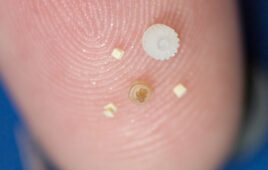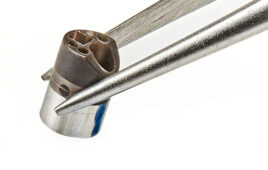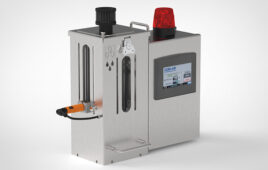Knowing the requirements of everyone involved in developing a rubber medical part during the design phase can speed the process right through production.
John Tranquilli, Apple Rubber Products

Molded rubber parts. (Image from Apple Rubber Products)
Designing a rubber medical part means taking multiple requirements into consideration.
A design engineer wants to get the part that will work in their assembly. Purchasing agents want to make sure they can meet the timetable and get the most cost-effective part. The quality engineer needs all the documentation to satisfy quality standards and information to pass regulatory reviews.
Here are four ways to make sure that part will meet those requirements and get to market on time.
Use the right material
With new material regulations being introduced, making sure you have the right material is critical. EU MDR (European Union Medical Device Regulations) is changing the requirements for materials used in medical devices.
Many design engineers use common rubber sealing material in prototype concept work. It’s the easiest to get and they may believe all rubber materials are the same. Before the product goes to market, a company’s regulatory department may
find the material not acceptable or requires a high level of testing to determine if the material is qualified for use.
Letting a rubber molder know the material is going to be used in a medical device will allow the molder to select the correct material. This will help streamline compliance and may eliminate future testing if the material is already tested. Medical-grade rubbers typically have been tested to FDA USP Class VI or ISO 10993.
Formulators also try to eliminate substances that are found on restriced-use lists, such as REACH, Prop 65 or EU MDR. Rubber compounds are typically made up of 20 or so individual ingredients, compared with plastic compounds that might only have three or fewer. Formulating medical rubbers requires an extensive review of these ingredients, including the purity level of each.
Rubber tolerance
Many standard title blocks have the same tolerance callout. These callouts are typically used in metal forming. High-precision lathes can cut metal to very high precision so tolerance is very low. A typical callout on three places is +/- .005 in.
This may work for small rubber parts, but in most cases, this is too low for rubber. The ingredients in a rubber formulation are mixed at a given tolerance. This can cause variations in the amount of shrinkage from batch to batch. In addition, molds are heated. The tolerance on a mold temperature profile can also cause shrinkage variations.
The combination of this tolerance stackup causes a higher degree of required dimensional tolerance. The Association of Rubber Products Manufacturers (ARPM) provides a standardized rubber tolerance guide based on the level of precision. High-precision would be A1, through commercial products at A3. Of course, the higher the precision, typically the higher the cost. Assuring the correct tolerance on a rubber part print will assure a part is quoted appropriately.
Surface finish
Unlike metal and plastic, which allow for a roughness tester to measure the peaks and valleys of surface imperfections, rubber is deformed when being tested by most devices. You can’t get a good measurement of roughness on a finished rubber part. A molder will most likely reject your addition of roughness specifications to prints. To get a specific texture on a part, the mold is textured. Since the molds are made from hardened steel, a measurement could be made on the tooling, if required.
Designers tend to put highly polished values on rubber goods. This could lead to problems. Highly polished flat surfaces will stick together during transport and customers will get a bag of stuck-together parts. Take the example of flat gaskets. If the mold is polished, the flat gaskets will stack up and will have to be peeled apart before use. Another example is polished O-rings. When using automated assembly systems, most use a vibratory bowl feeder. These can cause the O-rings to form columns and stop the feeding system. In both cases, a textured finish will help prevent this and should not affect sealing, because the rubber is going to deform into your sealing mating components.
Quality documents
Typically before medical devices go to market, a full regulatory review is completed. This can cause long delays when the requirements are not known in the pre-production phase and can postpone the market launch. Rubber molders need to know the required documentation before approving prototype or production tooling.
Design engineers may want to have their quality department contact the molder to relay this information. This will allow the molder to properly quote the required workload. It also allows them to assure no schedule conflicts. Standard first article Inspection reports are common when new tooling is purchased. Full IQ/PQ/OQ process validations can require many hours to complete, especially if there is large-cavity tooling like a small O-ring tool.
With a little work during the design phase, rubber medical parts can have a smooth sailing right through production. Rubber molders want to make sure a customer gets the part they want, but also want to make sure the correct paperwork is supplied.
John Tranquilli is a rubber chemist and materials manager at Apple Rubber Products, where he has worked for 23 years. He holds a B.S. in Chemical Engineering from the University at Buffalo.
The opinions expressed in this blog post are the author’s only and do not necessarily reflect those of Medical Design and Outsourcing or its employees.



